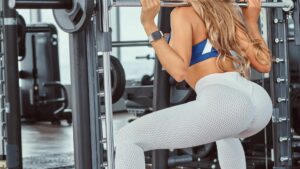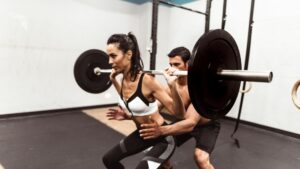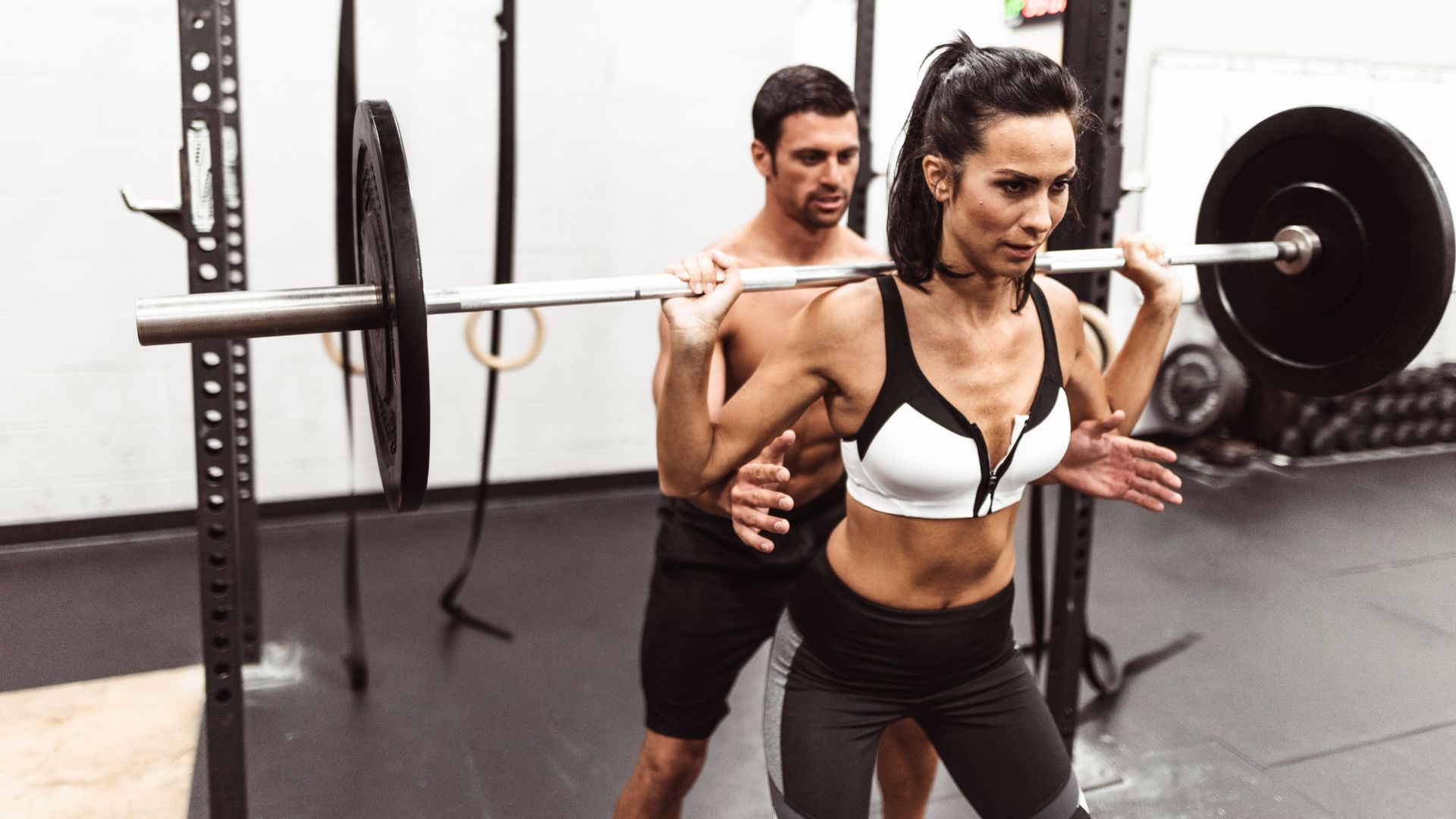Hey there, fitness enthusiasts! If you’ve ever wondered about the secrets to sculpting those glutes and enhancing your lower body strength, you’ve come to the right place. In this blog post, we’re diving into the world of squats and discovering the best squat stance to target those all-important glute muscles.
Whether you’re a gym regular or just getting started on your fitness journey, we’ve got the tips and insights you need to make your squats work wonders for your backside.
So, let’s get started and unlock the power of the perfect squat stance!”
Understanding The best squat stance for glutes: why and how.
The best squat stance for targeting the glutes can vary from person to person, as individual anatomy, flexibility, and biomechanics play a significant role.
However, I can provide you with some general guidelines to help you find a squat stance that may be effective for targeting the glutes.
here is the thing:
Hip Width Stance: Start with your feet about hip-width apart. This is a good starting point for most people. It allows for a balanced and stable base while engaging the glutes.
Toes Slightly Pointed Outward: Turn your toes slightly outward, typically around 15-30 degrees. This can help with hip mobility and activate the glutes more effectively.
Depth of Squat: To target the glutes more, aim for a deeper squat where your thighs are at least parallel to the ground or even lower. This deeper squat engages the glutes more than a shallow squat.
Knees Tracking Over Toes: Make sure your knees are tracking in the same direction as your toes during the squat. This helps to reduce unnecessary stress on the knees and enhances glute engagement.
Engage Core Muscles: Keep your core muscles engaged throughout the squat to stabilize your spine and pelvis, which can enhance glute activation.
Use Proper Form: Proper form is crucial to prevent injury and maximize glute engagement. Ensure your back is straight, chest is up, and you’re pushing your hips back and down.
Experiment and Adjust: Everybody is different, so don’t be afraid to experiment with your squat stance. You may find that a wider or narrower stance works better for you. Listen to your body and adjust as needed.
Variations: Different squat variations can also target the glutes differently. For example, sumo squats with a wider stance or goblet squats with a kettlebell can place more emphasis on the glutes.
Remember that it’s essential to warm up properly, progressively increase the weight you’re lifting, and prioritize good form over heavy weights to avoid injury.
Additionally, consider incorporating other glute-focused exercises like lunges, deadlifts, and hip thrusts into your routine to develop well-rounded glute strength and shape.
Further Explanations.
Let’s delve deeper, let me explain these points mentioned further.
Hip Width Stance.
Starting with your feet hip-width apart means positioning your feet so that they are approximately as far apart as your hip joints when you’re standing upright.
This stance provides a balanced and stable base for performing squats. Here’s why it’s beneficial:
Stability:
A hip-width stance creates a solid foundation for your squat. It allows you to distribute your weight evenly between your feet, which helps with balance and prevents you from leaning too far forward or backward.

Engaging Multiple Muscles:
When your feet are hip-width apart, you engage various lower body muscles, including the quadriceps, hamstrings, and glutes. This balanced engagement is essential for overall lower body strength and development.
Toes Pointed Slightly Outward.
Turning your toes slightly outward, usually at an angle of 15-30 degrees, is a technique used to optimize your squat form. Here’s how it works:
Hip Mobility:
This foot positioning allows for better hip mobility during the squat. When your toes are pointed slightly outward, it’s easier for your hips to open up, which is essential for achieving a deep squat while maintaining good form.
Glute Activation:
The slight outward rotation of your toes can also help activate the glutes more effectively.
When your toes point forward, there can be a tendency to use the quadriceps more dominantly. The outward toe angle can shift the emphasis toward the glutes, making them work harder during the squat.
Knee Alignment:
It can also help with proper knee alignment. When your toes are pointed outward, it’s often more natural for your knees to track in the same direction as your toes as you descend into the squat. This reduces the risk of knee strain and injury.
In other words, a hip-width stance with toes slightly pointed outward is a widely recommended squat stance because it promotes balance, stability, and effective engagement of the glutes and other lower body muscles.
However, it’s essential to remember that individual anatomy and preferences can vary, so some people may find slight adjustments to this stance more comfortable or effective for their unique biomechanics.
As such, it’s a good starting point for most people, but don’t hesitate to make minor adjustments based on your comfort and what feels right for your body.
let’s delve into the concepts of squat depth and knee tracking in more detail:
Depth of Squat.
To effectively target the glutes during a squat, achieving an adequate depth is crucial. Here’s why:
Glute Activation:
Going deeper in your squat, where your thighs are at least parallel to the ground or even lower (commonly referred to as a “parallel” or “below parallel” squat), places greater demand on the glutes.
This is because the glutes are highly engaged when you need to push your body back up from a deeper squat position.
Full Range of Motion:
A deeper squat allows you to utilize a broader range of motion, which can lead to improved muscle activation and development in the glutes. It also promotes better flexibility and mobility in the hip joints.
Balanced Strength:
A deep squat helps ensure that you are working your glutes through their full range of motion, which contributes to more balanced muscle development and can reduce the risk of muscle imbalances and injury.

Knees Tracking Over Toes.
Proper knee tracking during a squat is essential for maintaining good form and reducing the risk of injury while optimizing glute engagement. Here’s why it’s important:
Joint Alignment:
When your knees track in the same direction as your toes, it helps maintain proper joint alignment.
This alignment minimizes undue stress on the knee joint, reducing the risk of injury, especially to the knee ligaments and tendons.
Glute Engagement:
Allowing your knees to track properly also ensures that your glutes are actively involved in the movement.
If your knees cave inward (commonly referred to as “valgus collapse”), it can lead to overuse of the quadriceps and underutilization of the glutes. Proper tracking helps distribute the load more evenly across the lower body muscles, including the glutes.
Stability:
Keeping the knees in line with the toes enhances overall squat stability. This is especially important when you’re lifting heavier weights. It helps you maintain balance and control throughout the squat.
In all this, achieving an adequate depth in your squat, where your thighs are at least parallel to the ground, and ensuring that your knees track in line with your toes are two critical factors for effective glute engagement and squat form.
These practices help target the glutes more effectively while reducing the risk of injury and promoting overall lower body strength and stability.
However, always start with a weight and depth that you can handle comfortably, and gradually progress as your strength and technique improve.
let’s explore the importance of engaging core muscles and using proper form during squats in more detail:
Engage Core Muscles.
Stabilizing the Spine and Pelvis:
Engaging your core muscles during a squat is crucial for stabilizing your spine and pelvis.
The core muscles, including the rectus abdominis, obliques, and transverse abdominis, act like a natural weightlifting belt, helping to keep your spine in a neutral position.
This is important for preventing excessive flexion or extension of the spine, which can lead to back pain or injury.
Enhancing Glute Activation:
When your core is engaged, it provides a stable foundation for the rest of your body.
This stability allows your glutes to work more efficiently because they don’t have to compensate for instability by taking on extra work. As a result, you can focus on targeting the glutes more effectively during the squat.
Improving Balance and Control:
A strong core also contributes to better balance and control during the squat. It helps you maintain an upright posture and prevents you from leaning too far forward or backward, which can throw off your balance and increase the risk of falling or injury.
Use Proper Form.
Maintaining a Straight Back:
Proper form involves keeping your back straight throughout the squat. This means your spine should be in a neutral position, with no excessive rounding (flexion) or arching (extension).
Maintaining a straight back helps distribute the load evenly across your spine and minimizes the risk of back strain or injury.
Chest Up:
Keeping your chest up is essential for maintaining good posture during the squat. It helps prevent your upper body from collapsing forward, which can lead to poor form and reduced glute activation. A lifted chest also encourages you to engage your core muscles more effectively.
Pushing Hips Back and Down:
Proper squat form involves initiating the movement by pushing your hips back and down. This movement pattern engages the glutes and hamstrings more effectively. It also helps prevent excessive stress on the knees, as your hips bear more of the load.
Knee and Foot Alignment:
Ensure that your knees are tracking in the same direction as your toes, as previously discussed. Your feet should remain flat on the ground, and your weight should be evenly distributed between your heels and the balls of your feet.
In other words, engaging your core muscles and using proper squat form are fundamental for both safety and maximizing glute engagement during squats.
By stabilizing your spine and pelvis, maintaining a straight back, and following the correct movement patterns, you can target your glutes effectively while reducing the risk of injury and promoting overall strength and stability.
Always start with lighter weights to practice proper form before progressing to heavier loads.
Let’s explore the concepts of experimenting with squat stance and incorporating different squat variations to target the glutes in more detail:
Experiment and Adjust.
Individual Variations:
While the hip-width stance with toes slightly pointed outward is a good starting point for most people, individual anatomical differences can play a significant role.
Some individuals may have wider or narrower hips, different limb lengths, or unique biomechanics. Therefore, it’s essential to experiment with your squat stance to find what feels most comfortable and effective for your body.
Comfort and Effectiveness:
Experimentation allows you to determine if a wider or narrower stance feels better for your joints and muscles.
Pay attention to how the squat stance affects your balance, the engagement of your glutes, and any discomfort or strain you may feel.
Listening to your body’s feedback is crucial for finding the optimal squat stance that works for you.
Gradual Adjustments:
When making adjustments, do so gradually and incrementally. Small changes in stance width or toe angle can make a significant difference in how a squat feels. It’s a process of fine-tuning your form over time.
Variations.
Sumo Squats:
Sumo squats involve taking a wider stance than a traditional squat, with your toes pointed significantly outward.
This variation places a strong emphasis on the inner thighs (adductors) and the glutes. Sumo squats can be an effective choice if you’re specifically looking to target the inner thighs and outer glutes.
Goblet Squats:
Goblet squats involve holding a kettlebell or dumbbell close to your chest as you squat. This variation encourages an upright posture and engages the core muscles.
It’s an excellent choice for beginners to practice proper squat form and build strength in the glutes, quads, and core simultaneously.
Bulgarian Split Squats:
While not a traditional squat, Bulgarian split squats are a single-leg exercise that targets the glutes effectively.
This exercise involves elevating one foot behind you and lowering your body into a lunge position. It places a substantial demand on the glutes of the working leg.
Box Squats:
Box squats involve squatting down onto a box or bench before standing back up. This variation can help you work on depth and proper form, as the box provides a consistent point to aim for when squatting. It’s a great option for building strength and muscle engagement in the glutes.
Incorporating various squat variations into your routine can be an excellent way to challenge your glutes from different angles and intensities.
Depending on your goals and preferences, you can choose the squat variation that best suits your needs and continually rotate them to keep your workouts interesting and effective.
Remember to use proper form and progressively increase the intensity as your strength improves.
A tabular on this topic here includes ratio.
Here’s a more detailed table that includes various squat stances, their descriptions, and their approximate impact on glute engagement:
| Squat Stance | Description | Glute Engagement Ratio (1-5) |
|---|---|---|
| Hip-Width Stance | Feet hip-width apart, toes forward | 3/5 |
| Toes Slightly Outward | Feet hip-width apart, toes turned slightly outward | 3/5 |
| Wide Stance (Sumo) | Feet wider than shoulder-width, toes pointed outward | 4/5 |
| Narrow Stance | Feet closer together, toes forward | 2/5 |
| Single-Leg (Bulgarian Split Squat) | One leg extended behind, one leg forward | 4/5 |
| Goblet Squat | Holding a weight close to your chest | 3/5 |
| Box Squat | Squatting onto a box or bench | 3/5 |
Explanation of the Glute Engagement Ratio (1-5):
- 1/5: Minimal glute engagement.
- 2/5: Low glute engagement.
- 3/5: Moderate glute engagement.
- 4/5: High glute engagement.
- 5/5: Maximum glute engagement.
This table provides a comprehensive overview of different squat stances, their descriptions, and their estimated impact on glute engagement.
Keep in mind that individual factors and preferences can influence your experience with each stance, so it’s essential to experiment and adjust your squat technique to find what works best for your unique body and goals.
Conclusion.
The best squat stance for targeting the glutes is typically a wide stance (Sumo squat) with your feet wider than shoulder-width apart and toes pointed outward.
This stance tends to provide the highest glute engagement. However, individual factors and preferences play a significant role, so it’s essential to experiment and find the stance that works best for you while maintaining proper form.

Hey there, it’s Mike Rrsq, the Editor-in-Chief over at Jsquat.com, and I’m absolutely obsessed with all things squat fitness! I’ve been lucky enough to get some serious recognition for my work in this field. With a solid background in the fitness and wellness industry, I’ve been there right from the get-go, helping shape this website into what it is today.
You see, I’m not just the boss around here; I’m also a passionate contributor. I love sharing my insights through my articles, and trust me, they’re not your run-of-the-mill stuff. Each piece I write is a labor of love, filled with my expertise and real-world experience in the fitness universe. So, if you’re into fitness and looking for some inspiration, you’re in the right place!

